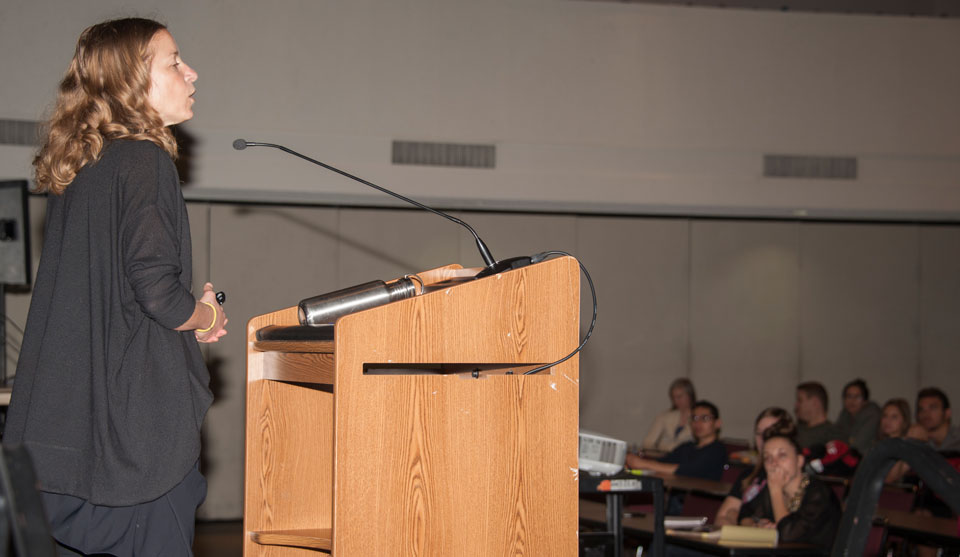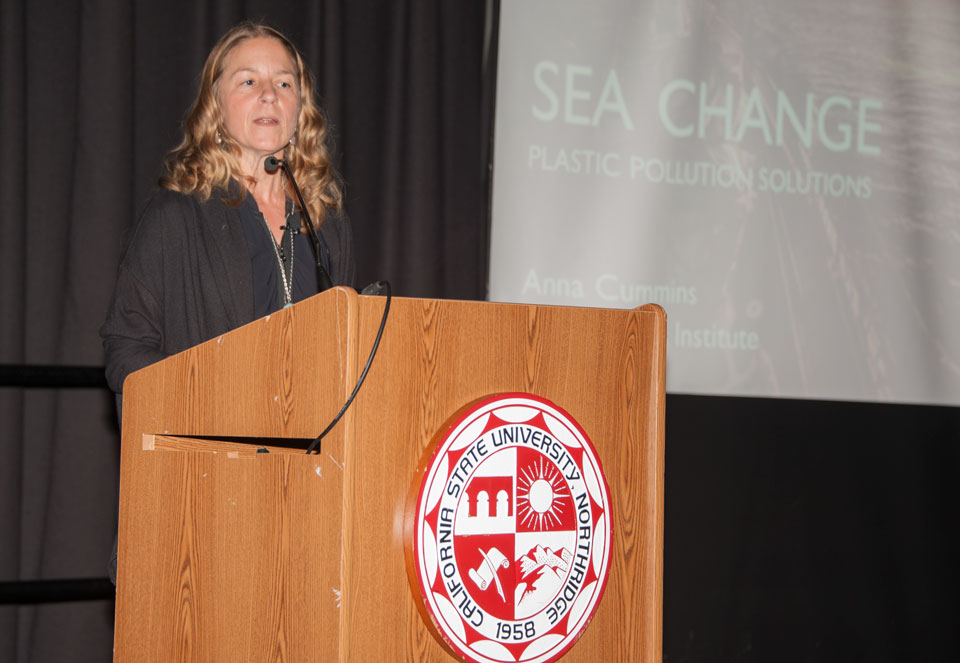Water Day Whets Students’ Appetites for Environmental Change
Stepping up to the podium in the Northridge Center, Anna Cummins immediately started talking trash.
The marine conservationist, activist and executive director of the 5 Gyres Institute presented an unvarnished, startling — and at times stomach-turning — peek into her crusade to stop plastic pollution in the world’s oceans, at California State University, Northridge’s annual Water Day. The March 11 event was organized by the Institute for Sustainability in the College of Humanities — and co-sponsored by the University Student Union — attracting more than 150 students and faculty members.
The half-day symposium also featured a screening of “Mulholland’s Dream,” a documentary on the history of California’s water system, and a presentation by CSUN geography professor Amalie Orme on “California Water: Past, Present and Future.”
In 2009, Cummins co-founded the Santa Monica-based nonprofit 5 Gyres Institute — named after the rotational currents in the world’s five major oceans, powered by wind and the planet’s rotation — with her husband, Marcus Eriksen. Inspired by research trips across the North Pacific Ocean, where they studied and documented massive “garbage patches” of plastic on the water’s surface, the pair launched the nonprofit organization to advocate for changes in policy and consumer behavior.
“We’ve taken plastic, this amazing material, and designed it poorly,” said Cummins. “It’s a design flaw. If we designed our way into it, we can design our way out of it.”
She noted that companies such as DuPont created petroleum-based plastics in the 20th century for industrial and military materials meant “to last forever,” but post-World War II, American consumers started to embrace single-use plastic disposables such as water bottles, bags, forks, plates, cups and shampoo bottles — and the world followed our lead.
“I was a student just like you, sitting in a lecture … when I heard a talk in 2001 from a man named Captain Charles Moore, about the ‘Great Pacific Garbage Patch,’ which is slowly filling up with plastic garbage,” Cummins told the crowd of CSUN students, many of them attending as part of a geography department class on climate change. The class is an elective and part of the minor in sustainability offered by the college’s Liberal Studies Program.
“I vowed to get involved, and I [later] got myself into a research trip to Guadalupe Island, off the coast of Baja,” said Cummins, who earned a bachelor’s degree from Stanford University and a master’s in international environmental policy from the Monterey Institute for International Studies. She urged CSUN students to get involved and take the initiative to volunteer, learn and work toward environmental change.
Sailing the North Pacific Gyre with her fellow researchers, Cummins said, she studied part of the “garbage patch,” an area about two to three times the size of North America awash in “plastic smog — like broken-down confetti.” The detritus washes out to sea from countries around the Pacific Rim and winds up in feeding grounds for marine life such as fish, sea turtles and sea birds, which mistake it for food and ingest it, or get entangled in the garbage.
“We’ve now come to think of the gyres as shredders, as eviscerators — they churn [plastic garbage] up into tiny particles,” said Cummins, who noted that the organization’s staff and volunteers have sailed some 50,000 miles around the world’s oceans, documenting the pollution. “Cleanup in the oceans is not where the solutions lie. The solutions lie upstream.
“I’m convinced that the solution lies in better design and advocacy,” she said. “It’s also important to live our values — to use reusable-design products, like water bottles and bags, avoiding single-use products.”
Cummins also invited CSUN students to get involved with the institute’s next summer research expedition, sailing in June to the Bahamas and Bermuda from Palm Beach, Fla.
The guest speaker was preaching to the choir, as most of the Water Day participants also had gathered to discuss and promote recycling, water conservation, recycling and other aspects of sustainability on campus and across the region.
“We are trying to make the campus sustainable, from composting to wastewater recycling and water management for irrigation,” said Helen Cox, director of the Institute for Sustainability. The institute helps coordinate those efforts with Associated Students and other campus organizations.
“Never underestimate the power of change on one campus,” Cummins told the crowd. “It sounds like you are doing some really great things at CSUN.”
In addition to Water Day, the Institute for Sustainability sponsors the semi-annual campus Orange Pick in CSUN’s historic orange grove, benefiting local food pantries, as well as the upcoming campus Earth Day celebration. The annual event is scheduled for 10 a.m. on April 23 at Bayramian Hall lawn, off Etiwanda Avenue (West University Drive) on campus.
For more information on the Institute for Sustainability, go to www.csun.edu/sustainability.




 experience
experience